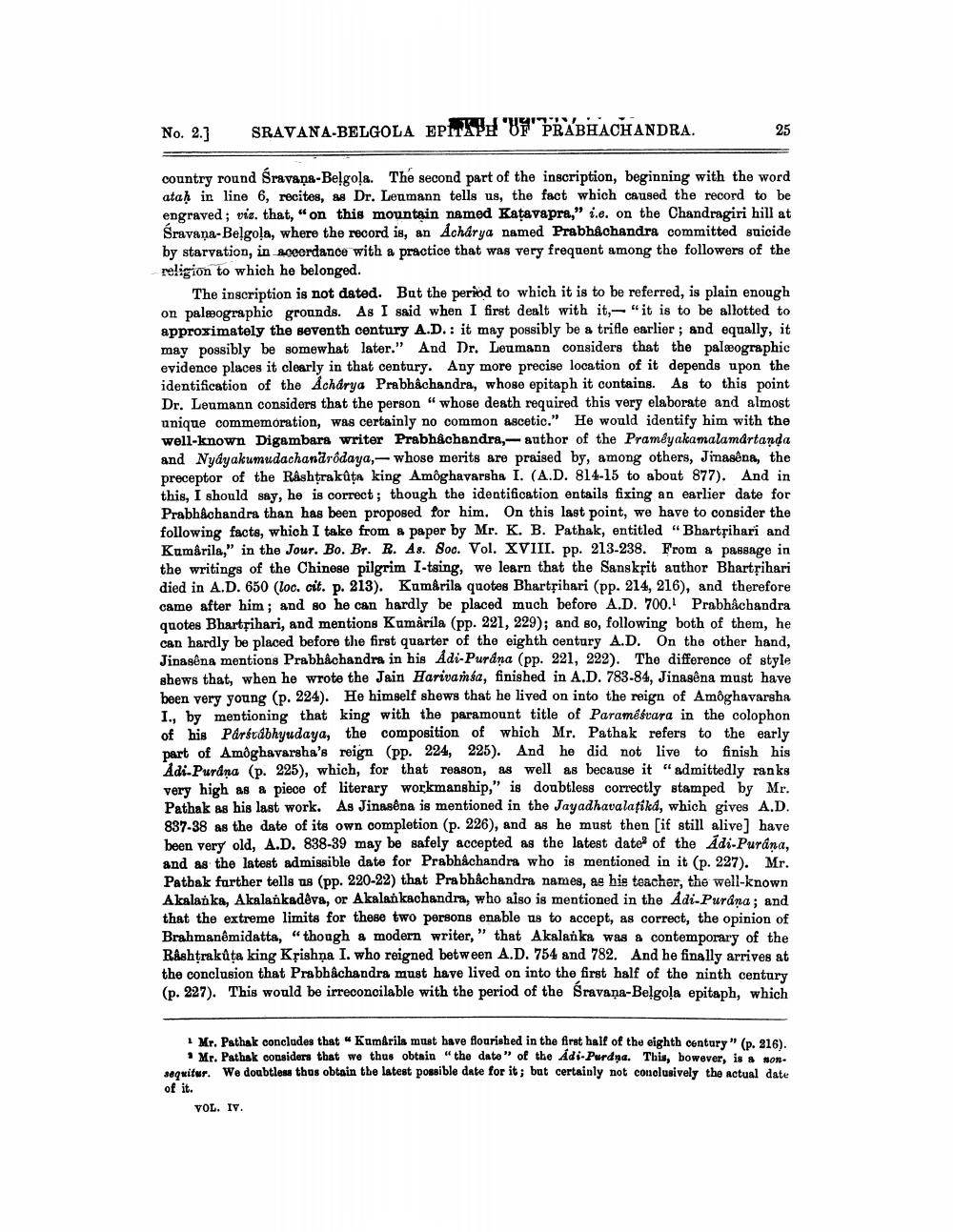________________
No. 2.]
SRAVANA-BELGOLA EPMAPH OF PRABHACHANDRA.
country round Śravana-Belgola. The second part of the inscription, beginning with the word ataḥ in line 6, recites, as Dr. Leumann tells us, the fact which caused the record to be engraved; viz. that, "on this mountain named Katavapra," i.e. on the Chandragiri hill at Śravana-Belgola, where the record is, an Acharya named Prabhachandra committed suicide by starvation, in accordance with a practice that was very frequent among the followers of the religion to which he belonged.
25
The inscription is not dated. But the period to which it is to be referred, is plain enough on paleographic grounds. As I said when I first dealt with it, "it is to be allotted to approximately the seventh century A.D.: it may possibly be a trifle earlier; and equally, it may possibly be somewhat later." And Dr. Leumann considers that the palæographic evidence places it clearly in that century. Any more precise location of it depends upon the identification of the Acharya Prabhâchandra, whose epitaph it contains. As to this point Dr. Leumann considers that the person "whose death required this very elaborate and almost unique commemoration, was certainly no common ascetic." He would identify him with the well-known Digambara writer Prabhachandra, author of the Pramêyakamalamartanda and Nyayakumudachandrôdaya,- whose merits are praised by, among others, Jinasêna, the preceptor of the Rashtrakuta king Amôghavarsha I. (A.D. 814-15 to about 877). And in this, I should say, he is correct; though the identification entails fixing an earlier date for Prabhachandra than has been proposed for him. On this last point, we have to consider the following facts, which I take from a paper by Mr. K. B. Pathak, entitled "Bhartrihari and Kumarila," in the Jour. Bo. Br. R. As. Soc. Vol. XVIII. pp. 213-238. From a passage in the writings of the Chinese pilgrim I-tsing, we learn that the Sanskrit author Bhartrihari died in A.D. 650 (loc. cit. p. 213). Kumarila quotes Bhartrihari (pp. 214, 216), and therefore came after him; and so he can hardly be placed much before A.D. 700. Prabhachandra quotes Bhartrihari, and mentions Kumarila (pp. 221, 229); and so, following both of them, he can hardly be placed before the first quarter of the eighth century A.D. On the other hand, Jinasena mentions Prabhâchandra in his Adi-Purana (pp. 221, 222). The difference of style shews that, when he wrote the Jain Harivamsa, finished in A.D. 783-84, Jinasêna must have been very young (p. 224). He himself shews that he lived on into the reign of Amôghavarsha I., by mentioning that king with the paramount title of Paramésvara in the colophon of his Pársvábhyudaya, the composition of which Mr. Pathak refers to the early part of Amoghavarsha's reign (pp. 224, 225). And he did not live to finish his Adi-Purána (p. 225), which, for that reason, as well as because it "admittedly ranks very high as a piece of literary workmanship," is doubtless correctly stamped by Mr. Pathak as his last work. As Jinasêna is mentioned in the Jayadhavalatika, which gives A.D. 837-38 as the date of its own completion (p. 226), and as he must then [if still alive] have been very old, A.D. 838-39 may be safely accepted as the latest date of the Adi-Purána, and as the latest admissible date for Prabhâchandra who is mentioned in it (p. 227). Mr. Pathak further tells us (pp. 220-22) that Prabhâchandra names, as his teacher, the well-known Akalanka, Akalankadêva, or Akalankachandra, who also is mentioned in the Adi-Purana; and that the extreme limits for these two persons enable us to accept, as correct, the opinion of Brahmanêmidatta, "though a modern writer," that Akalanka was a contemporary of the Rashtrakuta king Krishna I. who reigned between A.D. 754 and 782. And he finally arrives at the conclusion that Prabhâchandra must have lived on into the first half of the ninth century (p. 227). This would be irreconcilable with the period of the Śravana-Belgola epitaph, which
1 Mr. Pathak concludes that "Kumarila must have flourished in the first half of the eighth century" (p. 216). Mr. Pathak considers that we thus obtain "the date" of the Adi-Purdna. This, bowever, is a nonsequitur. We doubtless thus obtain the latest possible date for it; but certainly not conclusively the actual date of it.
VOL. IV.




